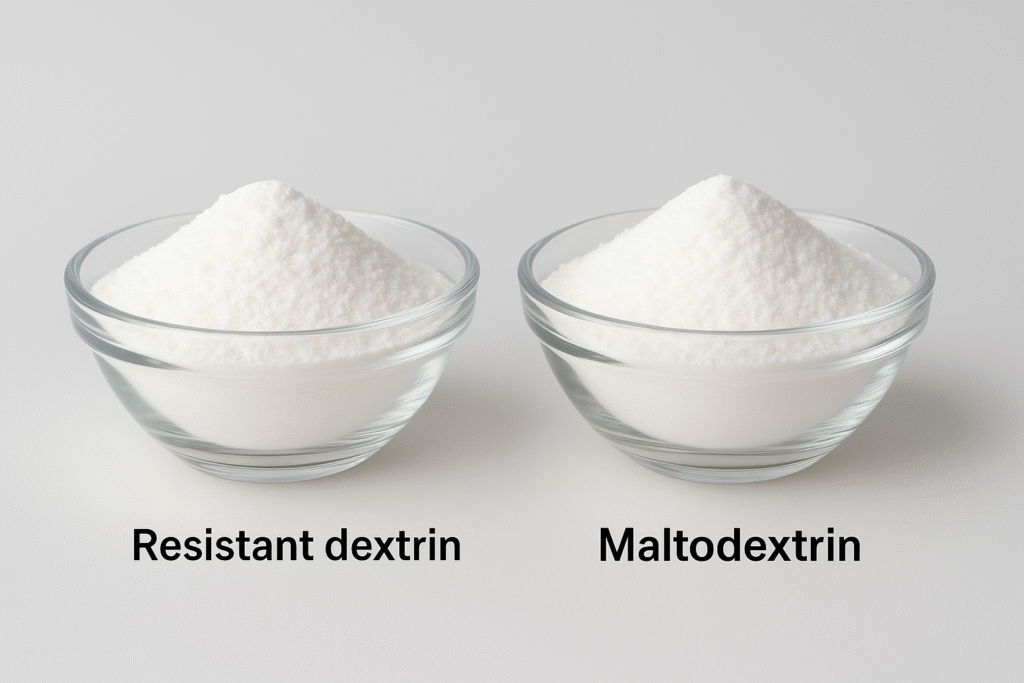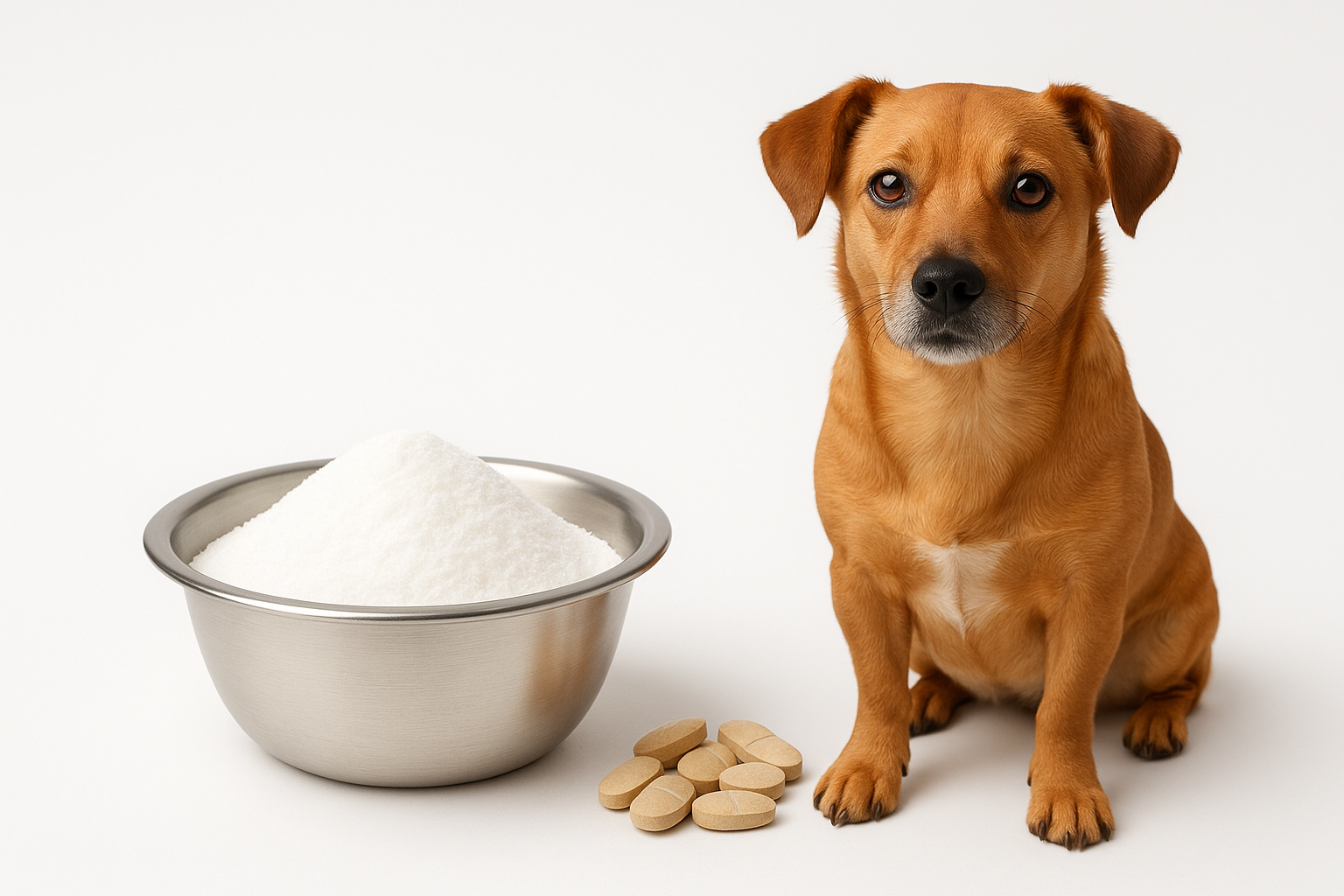
Many manufacturers use dietary fibers and carbohydrates in food, beverage, and supplement formulations. But not all carbohydrates behave the same way inside the human body. Confusion often arises between Resistant Dextrin and Maltodextrin — two similar-looking yet functionally distinct ingredients. The problem is that choosing the wrong one can change calorie content, sweetness, digestion rate, and even how a product claims “high-fiber” or “low-glycemic” benefits. Understanding their differences helps U make accurate technical and marketing decisions that enhance product performance and compliance.
Resistant Dextrin and Maltodextrin differ in digestion, glycemic impact, and functionality. Resistant Dextrin is a soluble dietary fiber that resists digestion and supports gut health, while Maltodextrin is a rapidly digestible carbohydrate used mainly as a filler or energy source. Although both come from starch, they serve entirely different roles in food and supplement applications.
To understand how these two ingredients differ, U need to look at their structure, digestion, and use across different industries.
1. What Is Resistant Dextrin?
Resistant Dextrin is a low-viscosity soluble dietary fiber produced by the controlled hydrolysis and roasting of starch. Its unique molecular structure makes it resistant to human digestive enzymes, allowing it to reach the large intestine where it supports beneficial gut bacteria.
Resistant Dextrin acts as a functional dietary fiber that promotes digestive health and maintains blood sugar balance.
| Property | Description |
|---|---|
| Source | Corn, tapioca, or wheat starch |
| Digestibility | Resistant to human enzymes |
| Function | Dietary fiber, prebiotic |
| Taste | Mildly sweet |
- Resistant Dextrin supports gut microbiota and helps regulate intestinal function.
- It is ideal for “high-fiber” and “sugar-free” claims in food and beverage applications.
2. What Is Maltodextrin?
Maltodextrin is a carbohydrate derived from partial hydrolysis of starch. It consists of short glucose chains that are rapidly absorbed by the body, providing quick energy but no fiber benefits.
Maltodextrin serves as an energy-yielding carbohydrate and bulking agent, commonly used in sports nutrition, instant foods, and supplements.
| Property | Description |
|---|---|
| Source | Corn, potato, or rice starch |
| Digestibility | Rapidly digestible |
| Function | Energy source, bulking agent |
| Taste | Neutral to slightly sweet |
- Maltodextrin enhances mouthfeel and texture in instant foods.
- It provides quick-release energy ideal for sports drinks and supplements.
3. What Are the Main Structural Differences?
Although both are starch derivatives, their molecular bonding patterns and chain lengths determine how the body processes them.
Resistant Dextrin has rearranged glycosidic bonds that resist enzymatic hydrolysis, while Maltodextrin retains digestible α-1,4 and α-1,6 bonds.
| Aspect | Resistant Dextrin | Maltodextrin |
|---|---|---|
| Bond Type | Complex, resistant bonds | Simple, digestible bonds |
| Chain Length | Short to medium | Short glucose chains |
| Digestibility | Low | High |
- Resistant Dextrin’s structure makes it function as fiber rather than energy.
- Maltodextrin’s linear glucose chains cause rapid energy release.
4. How Do Their Digestive Properties Differ?
Their physiological effects differ dramatically due to how each interacts with the digestive system.
Resistant Dextrin resists digestion and supports beneficial bacteria, while Maltodextrin is broken down into glucose and absorbed quickly.
| Feature | Resistant Dextrin | Maltodextrin |
|---|---|---|
| Digestibility | Poor (acts as fiber) | High (energy source) |
| Glycemic Index | Low | High |
| Prebiotic Effect | Yes | No |
- Resistant Dextrin helps reduce post-meal blood sugar spikes.
- Maltodextrin raises energy levels rapidly but may affect glycemic balance.
5. What Are Their Industrial Applications?
Their distinct properties define their roles in various industries, from food to supplements.
Resistant Dextrin is used in functional foods, weight management, and gut health products, while Maltodextrin is used in energy drinks, powdered mixes, and pharmaceutical excipients.
| Industry | Resistant Dextrin Use | Maltodextrin Use |
|---|---|---|
| Food | Fiber enrichment | Bulking and texture |
| Beverages | Low-calorie drinks | Sports drinks |
| Supplements | Prebiotic formulas | Energy blends |
- Resistant Dextrin improves product functionality without altering taste.
- Maltodextrin provides stable texture and instant solubility.
6. Which One Should U Choose for Your Formulation?
The right choice depends on your formulation goals — fiber enhancement or energy delivery.
Use Resistant Dextrin for fiber-rich, low-glycemic products, and Maltodextrin for energy-focused or textural applications.
| Goal | Recommended Ingredient | Reason |
|---|---|---|
| Improve Digestive Health | Resistant Dextrin | Boosts fiber and gut balance |
| Add Bulk to Tablets | Maltodextrin | Excellent filler and binder |
| Reduce Sugar Content | Resistant Dextrin | Low glycemic index |
| Increase Energy | Maltodextrin | Fast glucose release |
- Resistant Dextrin suits fiber-based and health-focused products.
- Maltodextrin suits instant, high-energy applications.
Conclusion
Though both originate from starch, Resistant Dextrin and Maltodextrin serve different nutritional and industrial purposes. Resistant Dextrin functions as a prebiotic dietary fiber, while Maltodextrin acts as a digestible carbohydrate for texture or energy. Understanding their key differences allows manufacturers to design formulations that meet both performance and health claims.
At Besty Pharma, U can find both Resistant Dextrin and Maltodextrin produced under strict GMP standards. Our ingredients deliver stable quality, consistent particle size, and excellent solubility for use in food, beverage, and supplement applications. As a professional dietary fiber and carbohydrate manufacturer, we offer customized solutions, OEM/ODM support, and formulation guidance to help U achieve ideal product performance.




